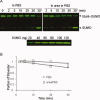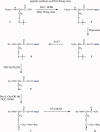Stability of thioester intermediates in ubiquitin-like modifications
- PMID: 19785004
- PMCID: PMC2821268
- DOI: 10.1002/pro.254
Stability of thioester intermediates in ubiquitin-like modifications
Abstract
Ubiquitin-like modifications are important mechanisms in cellular regulation, and are carried out through several steps with reaction intermediates being thioester conjugates of ubiquitin-like proteins with E1, E2, and sometimes E3. Despite their importance, a thorough characterization of the intrinsic stability of these thioester intermediates has been lacking. In this study, we investigated the intrinsic stability by using a model compound and the Ubc9 approximately SUMO-1 thioester conjugate. The Ubc9 approximately SUMO-1 thioester intermediate has a half life of approximately 3.6 h (hydrolysis rate k = 5.33 +/- 2.8 x10(-5) s(-1)), and the stability decreased slightly under denaturing conditions (k = 12.5 +/- 1.8 x 10(-5) s(-1)), indicating a moderate effect of the three-dimensional structural context on the stability of these intermediates. Binding to active and inactive E3, (RanBP2) also has only a moderate effect on the hydrolysis rate (13.8 +/- 0.8 x 10(-5) s(-1) for active E3 versus 7.38 +/- 0.7 x 10(-5) s(-1) for inactive E3). The intrinsically high stability of these intermediates suggests that unwanted thioester intermediates may be eliminated enzymatically, such as by thioesterases, to regulate their intracellular abundance and trafficking in the control of ubiquitin-like modifications.
Figures




References
-
- Yeh ET, Gong L, Kamitani T. Ubiquitin-like proteins: new wines in new bottles. Gene. 2000;248:1–14. - PubMed
-
- Hershko A, Ciechanover A. The ubiquitin system. Annu Rev Biochem. 1998;67:425–479. - PubMed
-
- Varshavsky A. The ubiquitin system. Trends Biochem Sci. 1997;22:383–387. - PubMed
-
- Schwartz DC, Hochstrasser M. A superfamily of protein tags: ubiquitin, SUMO and related modifiers. Trends Biochem Sci. 2003;28:321–328. - PubMed
Publication types
MeSH terms
Substances
Grants and funding
LinkOut - more resources
Full Text Sources
Miscellaneous

